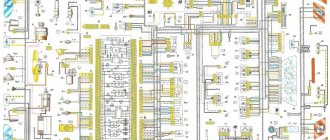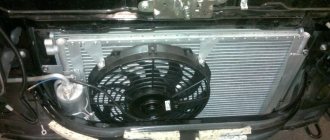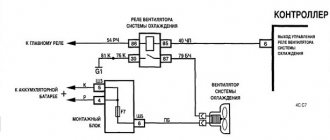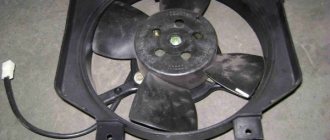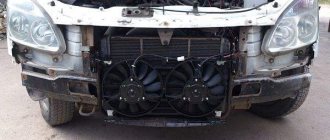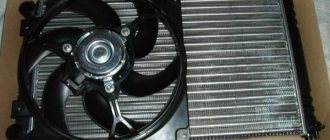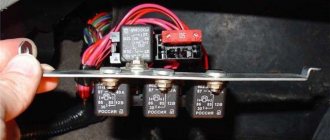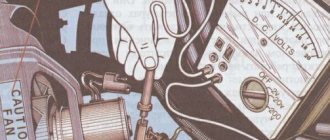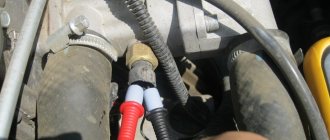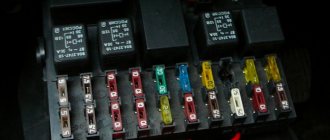Owners of popular Lada Kalina models often encounter situations when the cooling fan does not turn on. This situation forces the driver to periodically stop to allow the engine to cool down. If a malfunction occurs in frosty weather, then it has almost no effect on the functionality of the system, but in warm periods it significantly prevents the LADA Kalina from moving smoothly.
Most Lada Kalina owners are not able to independently diagnose the reasons why the cooling fan does not turn on, much less eliminate them. Tow trucks and services, as well as a switching diagram, are happy to come to their aid.
Reasons for fan failure
Here we indicate the most likely places in the cooling circuit, which you should take a closer look at if the cooling fan does not turn on.
- Thermostat. When the specified product fails, the fan also begins to make itself known through malfunctions and incorrect activation. To diagnose the thermostat, you will need to touch the outlet pipe (located at the bottom) of the LADA Kalina radiator on a warm engine. If this hose is warmed up, then the unit is normal; when it is cold, we determine that the thermostat is faulty. Since a part can break down quite often, it is recommended to carry a spare part with you. Replacement is not a difficult operation. To perform this, you will need to first drain the liquid from the circuit.
- Fuse and switching relay. These elements of the electrical circuit are also capable of frequent failure. Using the diagram of the location of the fuse links, we find the required fuse in the mounting block, remove it and check for burnout of the working “hair”. The block with these elements is located inside the cabin under the dashboard. To protect the fan circuit, an insert with a maximum current of 50 A is used. The fuse number is “3”.
The relay responsible for the operation of the node in question is listed as number “1”.
- Additional module for controlling fan functionality. To remove it, you will need to dismantle the air duct for supplying a warm air stream and, using the “10” key, unscrew the fasteners. Having taken out the block, we find a pair of switching relays responsible for the “command” to switch on and the maximum speed. Both elements can be diagnosed using a tester.
- Let's move on to the electrical switching of the fan. Using the same device, we check the wire lines of the node. If we find a break, we replace the wire with a new one with the same cross-section.
- Fan winding. Here the owner of the Lada Kalina feels despondent, since with such a malfunction, a replacement option is very likely, which is not cheap.
- Device activation sensor. If it is faulty, the fan will not activate, thereby causing the risk of overheating the power unit.
Description
It is known that every Priora and Kalina has a cooling system that ensures normal engine operation and prevents it from overheating. One of the cooling devices of the unit is a fan sensor, the signal from which activates the ventilation device.
In Kalinas devices, this controller is designed so that it turns on the fan when the engine temperature reaches a certain point. Thanks to the fan, which must turn on according to a signal from the controller, the engine temperature will always be normal and will not exceed the permissible threshold. If the device does not work, the fan does not turn on, and the engine may overheat.
Sensor connection diagram in the cooling system
How to replace a fan in Kalina?
The replacement process, if the cooling fan does not turn on, is quite a troublesome task, which is influenced by the tightness of free space for manipulation. So let's get started.
- 1. Here it is necessary to avoid the need to remove the radiator, which involves draining the fluid and takes more time.
- 2. Dismantle the housing of the filter element of the air intake system.
- 3. Remove the front grille.
- 4. Unscrew the fasteners of both head lighting devices.
- 5. We use a “10” head, through which we unscrew the fasteners of the upper front panel.
- 6. Now you need to disconnect the connectors that serve to connect the electrical fan module with the on-board network. We take the wires to the side to avoid interference.
- 7. The fan frame is secured with 4 bolts that need to be unscrewed.
- 8. We remove the fan with extreme care so as not to damage the nearby components of the engine compartment.
Installing the device involves performing manipulations using the reverse algorithm.
Diagnostics and repair of possible faults
To carry out repairs, you will have to replace faulty parts.
Replacing the thermostat
To change the thermostat, you will need to drain the coolant and remove the inlet and outlet pipes. Then, unscrew the cap and replace the thermostat.
Fan replacement
Appearance of the new radiator cooling fan
Replacing a fan on Kalina is not a quick task and takes some time. So, let's look at how to replace the Lada Kalina cooling fan with your own hands.
- In order not to remove the radiator, we do everything with utmost care so as not to damage other parts.
Remove the air filter.
Removing the air filter
The arrows indicate the cooling fan mounting bolts
Replacing relays and fuses
Replacing relays and fuses is quite easy. You need to remove the burnt ones and replace them with new ones that were purchased according to the markings on them.
Replacing relays and fuses
These protective and fan control components are fairly easy to replace. We remove the burnt element from the mounting socket and install a new analogue. It is convenient to use suitable tweezers here.
Steering rack Kalina
How to drain antifreeze from Kalina
Adjusting the Kalina generator belt
Repair of the cooling system on Lada Kalina
On the Lada Kalina car, after the antifreeze temperature reaches 95 degrees, the fan automatically turns on. If it does not turn on, the running engine begins to quickly gain temperature. You have to stop, otherwise the pistons will jam and the engine will break down.
Functional elements of the Kalina cooling system
- Large radiator. Installed in the front part of the Lada Kalina to cool the fluid and reduce the temperature during engine operation. Cooling occurs due to a strong air flow of cold air.
- Cooling Fan. Installed directly on the radiator. Thanks to the fan, the liquid cools much faster.
- Stove radiator. Due to the warm air, the car interior warms up.
- Expansion tank. Since one of the properties of coolant is the ability to respond to temperature fluctuations, a special tank is installed. As antifreeze expands or contracts, it compensates for the amount of coolant in the system.
- Water pump. A special device that circulates coolant throughout the vehicle.
- Thermostat. A very important detail, despite its miniature size. The thermostat regulates the flow of fluid that moves through the engine radiator. The thermostat maintains the optimum operating temperature of the engine.
- Temperature sensor. When the temperature rises above normal, the sensor signals this fan relay to turn on instantly.
Improvements to the Kalina fan
In the Lada Kalina, the cooling circuit can be upgraded, which will significantly reduce the risk of forced shutdown due to the failure of one of the system components. The first step is to install a more reliable thermostat. Some LADA Kalina owners install a 6-hole unit and also supplement the circuit with a second stove valve and install another pump.
The second improvement option involves installing a “sports” version of the fan. This product is equipped with its own controller that can show the functioning of the system. Here you simply cannot do without making certain adjustments to the electrical circuit.
It would also be a good idea to install an additional button for forced activation of the fan. Most often it is located on the panel.
What if the fan completely stopped working?
To determine the cause of such a malfunction, you first need to check the condition of the fuse in the electrical circuit. It can be found on the side console, near the passenger seat. It is hidden under the deflector cover. By unscrewing the screw, the cover can be easily removed and the fuse will be available for examination.
To remove the entire safety block and connected relays, the mount must be released. You can't do this without wrenches. You need to remove the unit carefully without haste, as you can damage the wires that are connected to it. Only the single fuse of the unit is responsible for the operation of the fan.
If the fuse is intact, it is necessary to check the operation of the relay that powers the fan motor. There are two such relays installed. The left one turns on low fan speed. And the one located on the right is responsible for the high speed of its operation.
Another problem that relates to the cooling fan relay is that the cooling fan continues to operate when the ignition is turned off. This may drain the battery. “Kalina” then simply won’t start. The main reason is sticking contacts. The block is exposed to antifreeze leaking from the radiator installed above the stove.
When the relays and fuses are working properly, you need to check the operation of the temperature sensor. It is he who orders the fan to start working. This sensor is located on the right side of the radiator tank.
To check its functionality, you need to remove the plug connector, take a jumper, and use it to short-circuit the connector terminals. The fan turning on indicates that the sensor is in good condition. If the fan does not react at all, then before changing the sensor, you need to check the functionality of the fan motor. To do this, the electric motor terminals must be connected to the battery contacts. The engine should start working. In case of failure, you will have to install a new electric motor.
Let's sum it up
If a cooling circuit fan in a Lada Kalina fails to operate, then such a malfunction can be corrected independently. We have reviewed almost the entire list of reasons that could cause a malfunction, and also provided an algorithm for replacing the unit. Use our material as instructions for action and tend to periodically inspect the cooling system; a switching diagram can also help you. This will minimize the risk of unpleasant circumstances occurring on the road.
Modernization of Kalina SOD
The main problem of the Kalina cooling system is the formation of air locks. Today there are a number of effective ways to eliminate this defect. The reason lies in the design features of the SOD. The operation of the cooling system is based on the interconnected functioning of many parts. The use of the large and small circuits depends on the temperature of the antifreeze circulating through the system. The normal operation of the entire power plant depends on this.
You can modify the cooling system yourself or at a service center. Professionals rarely engage in all sorts of modifications, recommending replacing or repairing a particular component. This method may be more expensive, but not always more effective.
Classic ways of improvement
In order to solve the problem with the formation of air locks, you need to remove the expansion tank cap and start the engine. Then wait until the coolant temperature rises to the critical red zone until forced cooling by the fan comes into operation. After this, you need to press the gas pedal several times and turn off the engine.
If the method is ineffective, there is another method. To do this, you need to dismantle the engine protection, loosen the clamp and remove one of the tubes of the throttle body heating fitting. Then unscrew the cap of the expansion tank and, applying a rag, start blowing into it until antifreeze begins to flow from the removed pipe. In order to modify the standard cooling system, many car owners install a more efficient 6-hole thermostat, install a coolant filter and another heater faucet.
To increase circulation efficiency, an additional pump is often installed.
Other upgrade options
If the car is equipped with an electronic gas pedal, the hose that previously went to heat the throttle assembly is now looped into the cooling system. To prevent the formation of air pockets, an additional pipe with a smaller diameter is used, which is installed instead of the above hose. The hose for the air duct is placed near the thermostat; for this, a tee is used, mounted in the pipe fitting to the radiator. The second end of the pipe is connected to the steam removal hose near the expansion tank (you will need another tee).
The modification ensures a stable operating temperature of 90 degrees in urban conditions, and the stove begins to warm up at 50 degrees.
The next improvement method is to equip the steam outlet with a special hydraulic fence. To do this, a tube from a dropper is mounted in the steam removal hose, which is immersed in antifreeze at the bottom of the expansion tank. As it cools, the antifreeze is drawn into the outlet pipe, which prevents air from the cooling system. If desired, you can combine both methods.
Causes of ventilation breakdowns
The fan allows you to create a forced air flow to cool the air conditioning system. The operational life of the unit depends on the quality of the equipment and the speed of rotation of its blades. If the technical specifications do not meet certain requirements, repair work is carried out. In some cases, the air conditioner radiator is replaced. In this case, you will need a diagram of the air conditioning and heating system of the Lada Kalina.
Heating system diagram
If the fan does not start, you need to find out the reason for the lack of cooling. It may be associated with a failed unit located in front of the radiator or under the dashboard. In the first case, the device has 2 rotation speeds. Speed 1 is characterized by outboard temperature, and speed 2 is characterized by high temperature.
Possible causes of the malfunction.
- Failures in the resistance block. To check it, you will need to turn on the power to the unit, bypassing the unit. If a zero result is obtained, the device is replaced or the winding is repaired.
- The speed relay regulator has failed. It must be dismantled and replaced with a new one.
The Lada Kalina has a resistance unit with 2 speeds. Using a special command, the 1st speed is activated. The temperature sensor and pressure sensor are responsible for turning on the 2nd speed. If the fan does not start immediately at speed 2, you need to check the relay regulator installed in the compartment with the motor of the unit in question. The relay and regulator are repaired or replaced with new ones.
Checking and replacing the Kalina cooling fan resistor
Removing the additional fan resistor is done as follows:
- put the car on the “handbrake”;
- open the hood;
- remove the ground wire from the battery;
- remove the engine splash guard;
- unscrew and remove the engine crankcase protection (if installed);
- press the block latch and unplug the electric fan power supply wiring harness;
- Using a Phillips screwdriver, unscrew the two screws holding the additional resistor;
- move aside the resistor mounting bracket together with the block;
- pull out the resistor.
Checking the resistor consists of two stages:
- visual inspection of the integrity of the spiral;
- checking the resistor winding for open circuit using an ohmmeter.
If a winding malfunction is detected, the resistor must be replaced with a new one. If the thermal fuse is faulty, then all you can do is replace it. To do this, you will need a soldering iron to remove the burnt fuse and solder a new one in its place. All that remains is to put the parts in their original places. Installation of the Kalina cooling fan resistor is carried out strictly in the reverse order of removal.
Cooling system malfunctions
First of all, this is due to antifreeze leakage. This malfunction is clearly visible under the hood of the car. In most cases, fluid leakage from the system occurs due to:
- lack of tightness on the pipes.
- clamps are outdated;
- the heating radiator is clogged;
- The cooling radiator is broken.
The heating radiator will have to be replaced, but a large radiator can be repaired. You just need to solder the holes. But it must be remembered that it is mainly the copper radiator that is soldered. The aluminum radiator installed on Kalina is rarely repaired. It is better to immediately replace it with a new one.
In case of constant overheating of the car engine, the first place is due to malfunctions of the cooling system:
- Thermostat. To check it, you need to warm up the engine. Use your hand to touch the pipes leading to the radiator. When the top pipe is completely cold, while the bottom pipe is slightly warm, we can talk about the thermostat being stuck. In this case, the liquid moves in a small circle. There is only one way to fix the problem - you need to install a new thermostat.
- The radiator honeycombs are completely closed. A common cause of abnormal operation of the cooling system. In most cases, this happens at the beginning of summer, when poplar fluff begins to fly. To get everything back to normal, you need to clean the outside of the radiator. Sometimes such work causes certain difficulties, but this is the only way to make the system work properly. You have to do manual work.
- The fan is broken. When the heating temperature exceeds 95 degrees and the fan is silent, several parts need to be checked:
- cooling fan relay;
- electrical wiring;
- sensor
After detecting problems, a new relay and sensor are installed, and the wires are replaced.
Air lock: features
"Kalina", like hundreds of other cars, is in no way protected from the appearance of an air lock. It cuts off the coolant supply. Solving this problem often involves some difficulties.
For a novice motorist who owns a Lada Kalina, an air lock is always a problem. To deal with it, you first need to remove the cap from the expansion tank. Then heat the engine to a temperature at which the gauge needle begins to reach the red zone. When the fan turns on, you need to press the accelerator pedal several times and turn off the ignition. Sometimes this is enough. The air lock completely disappears.
However, if the plug remains, more specific measures must be taken:
- The plastic screen is being dismantled;
- the clamp is released;
- the tube is removed from the fitting located on the throttle assembly;
- the expansion tank opens, its neck must be closed with a rag;
- Air is supplied to the open expansion tank until liquid begins to pour out of the tube. If it was not possible to break through the air plug in this way, you need to close the lid and return the removed tube to its place.
- then you need to warm up the engine again and turn off the ignition;
- remove the heating tube, but do not remove the cover. You need to wait a little until the liquid begins to pour out of the tube.
Since coolant is a toxic substance, this operation must be performed very carefully. Safety precautions require gloves.
During operation, you need to check the temperature of the tubes. The engine must be completely cool.
After draining the liquid, the tube is put on the fitting and tightened with clamps. Thus, the air from Kalina will be completely removed. This work can be done by any motorist; the help of a specialist is not needed. In order for Kalina to be free from such problems, it is necessary to constantly check the tightness of all connections and tighten the clamps.
Main functional elements of the cooling system
Before you figure out why the Kalina engine cooling fan does not work, you should understand what the cooling system consists of in general. This may include:
- fan. The device is located on the radiator itself. When the antifreeze temperature reaches a certain value (on viburnum it is 95 degrees), the fan starts working, which speeds up the cooling process;
- temperature sensor. It sends a signal to start the fan when the motor temperature begins to rise;
- expansion tank. Antifreeze reacts very sharply to temperature fluctuations. When it contracts or expands, the expansion tank allows it to compensate for the change in fluid volume;
- water pump. Thanks to the pump, antifreeze circulates throughout the system;
- thermostat. The device is responsible for the process of supplying fluid to the radiator. It is this element that controls and maintains a stable temperature in the power unit.
A breakdown of any device leads to a situation where the cooling fan on the 8-valve Kalina does not work.
Next in the video is a solution to the problem when the cooling fan does not turn on in Kalina:
List of contact relays
If we open the main fuse box of Kalina 2, we will see a set of electrical relay housings. There are no other blocks containing relays in the car. We list the elements used in the “Lux” package (21927/21947):
- K1: radiator fan relay;
- K2: relay switching on door locks;
- K3: additional starter relay;
- K4: additional relay (switches current 50A);
- K6: wiper relay;
- K7: relay that turns on the high beam;
- K8: signal relay;
- K9: relay that turns on the low beam;
- K10: rear window heater relay;
- K11: main ignition relay;
- K12: relay turning on the fuel pump;
- K13: additional relay;
- K14: radiator fan relay 3;
- K15: windshield heater relay 1;
- K16: windshield heater relay 2;
- K17: relay that turns on the air conditioning compressor.
You can compare the layout of elements in “Lux” and in “Norm/Standard”:
Let's consider the data relevant for the “Normal/Standard” configurations:
- K1-K12: as above;
- K13: radiator fan relay 3;
- K14: windshield heater relay 1;
- K15: windshield heater relay 2;
- K16: air conditioning compressor relay.
The last list is also relevant for Kalina Cross Norma. And in more expensive trim levels of the crossover, the “Lux” scheme will probably be used.
Album of electrical circuits of VAZ 1118
The VAZ 1118 operation and repair manual contains an album of all electrical circuits of the car. The general electrical equipment diagram of the Lada includes 59 elements: sources, consumers, protective elements, ECU (electronic control unit), sensors. Consumers of electricity in Lada are lamps (headlights, interior lighting, license plate, instrument panel, glove compartment), electric drive of the main vehicle options, switches and a sound signal.
A separate electrical diagram of the engine control system connections is shown with the designation of the main elements (spark plugs, injectors, ignition coil). The manual describes the front and rear wiring harness diagram, instrument panel wiring harness connection, door wiring harness connection, and air intake box wiring harness connection.
To ensure reliable contact of the wires, they are combined into terminal blocks. Each block has colored wires. The color in the diagram corresponds to the color of the wire on the car.
When reading an electrical diagram, you can determine by the number next to the wire which connector it is connected to. The designation 9/14 indicates that two wires are connected together and connected to the 9th block through the 14th connector.
When is it advisable to repair it yourself and in the service?
If your car has problems with the electric fan of the cooling system, you can fix the problem in the sequence described above. Almost any repair can be done by yourself. Since the main problems come down to faulty sensors, replacing them will not be difficult. It is enough to dismantle the faulty part and install a new one in its place. If the problem lies in bad contacts, then they can be cleaned or, as a last resort, the connectors can be replaced. If you are not confident in your abilities, then in order to avoid new problems it is better to contact the service.
Video: solving the problem of a constantly running fan
To decide whether to carry out independent repairs in case of problems with the cooling fan or seek outside help, you can familiarize yourself with the approximate prices for a particular operation.
Table: cost of repairing the cooling system with your own hands and in the service
| Name | Approximate cost, rub. | |
| On one's own | In service | |
| Replacing the Fan Sensor | from 150 | from 500 |
| Checking coolant leaks | for free | from 500 |
| Checking the coolant level | for free | from 500 |
| Replacing the cooling fan | from 500 | 500–1000 |
| Minor wiring repairs | for free | 200–500 |
| Radiator cleaning | for free | From 800 |
| Replacing the thermostat | from 350 | From 800 |
Constant rotation of the cooling fan on a cold engine is not normal. Therefore, you should deal with the malfunction that has arisen, find and eliminate the cause of its occurrence in order to prevent rapid wear of the device. Diagnostics consists of checking the coolant level, as well as the elements responsible for the operation of the electric fan, which every car owner can do.
Source
Why does the fan switch sensor not work on Kalina and Priora and what to do about it?
Modern domestically produced cars are equipped with various controllers and sensors that ensure full operation of the car. If one of the devices fails, this can lead to incorrect operation of the nodes. From this material you can find out what the Priora and Kalina fan switch is and what malfunctions are typical for it.
